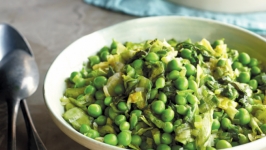English Peas
Fresh, sweet English peas are a highlight of spring, and as soon as I see these large, thick-podded peas appearing at our local markets I begin to celebrate the arrival of the new season.
I always buy several pounds at a time, knowing that each pound will yield about one and one quarter cups of shelled peas—if I don’t eat too many fresh out of hand. The first night I cook the peas with just a bit of chopped romaine or butter lettuce, some butter and a splash of water. This is a recipe for pure, stand-alone pea flavor, to be savored perhaps with grilled lamb chops or a poached chicken breast.
Next up, risotto with peas and morel mushrooms (morels are another highlight of spring), followed by turkey potpie—peas are essential for a proper potpie—and, if ambitious, I make up a batch of potato-and-peafilled samosas. Fresh peas in a frittata finished with a dollop of crème fraîche and mint is another favorite of mine, as is pea and asparagus gratin, well-napped with Mornay sauce and a sprinkle of buttered breadcrumbs.
I keep buying fresh peas as long as they are available, knowing that the rest of the year I’ll have to make do with frozen, or the pre-shelled and bagged peas I can sometimes find at the supermarket, but they are not the same in flavor or texture as fresh-shelled peas.
On the other side of the old-fashioned thick-podded English pea, cultivated for over 10,000 years, is the edible pod pea, a relatively recent development, dating back a couple of hundred years. These are more widely available most of the year. The most popular type, the Sugar Snap, has an edible pod about one-third the size of the English pea pod. Most of the actual peas inside the pod are smaller, as well. Snow peas, with their edible pod, are also available most of the year. These have only tiny, immature traces of peas inside the thin pod. While these newer varieties are good, in my mind they can’t take the place of a fresh English pea.
What to look for when choosing fresh English peas? The pod should be green, not tending toward yellow, and the peas inside should be large but not huge, as that is an indicator the peas are starting to turn starchy and hard. The pod should be plumped with peas, as a flattish pod indicates the peas inside aren’t developed.
The more tender the peas, the less cooking time is needed. Generally, three to five minutes is sufficient. As the season progresses, you may find peas that are on the more mature side, and these starchy peas, well-suited to mashes and spreads, will need considerably longer cooking.
Whether you are cooking peas on their own or as part of a multi-ingredient dish, savor them in the moment. They won’t last forever.






